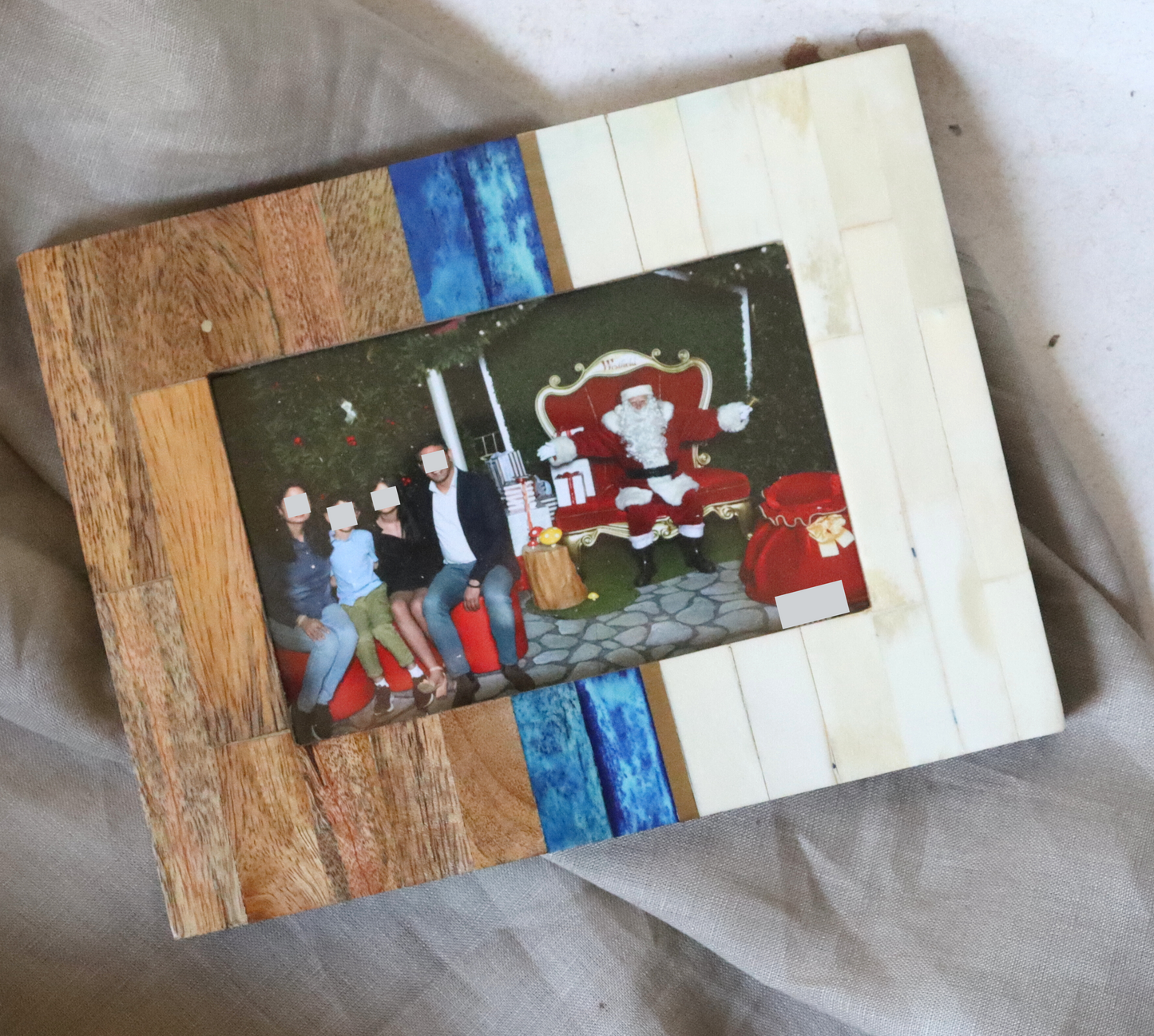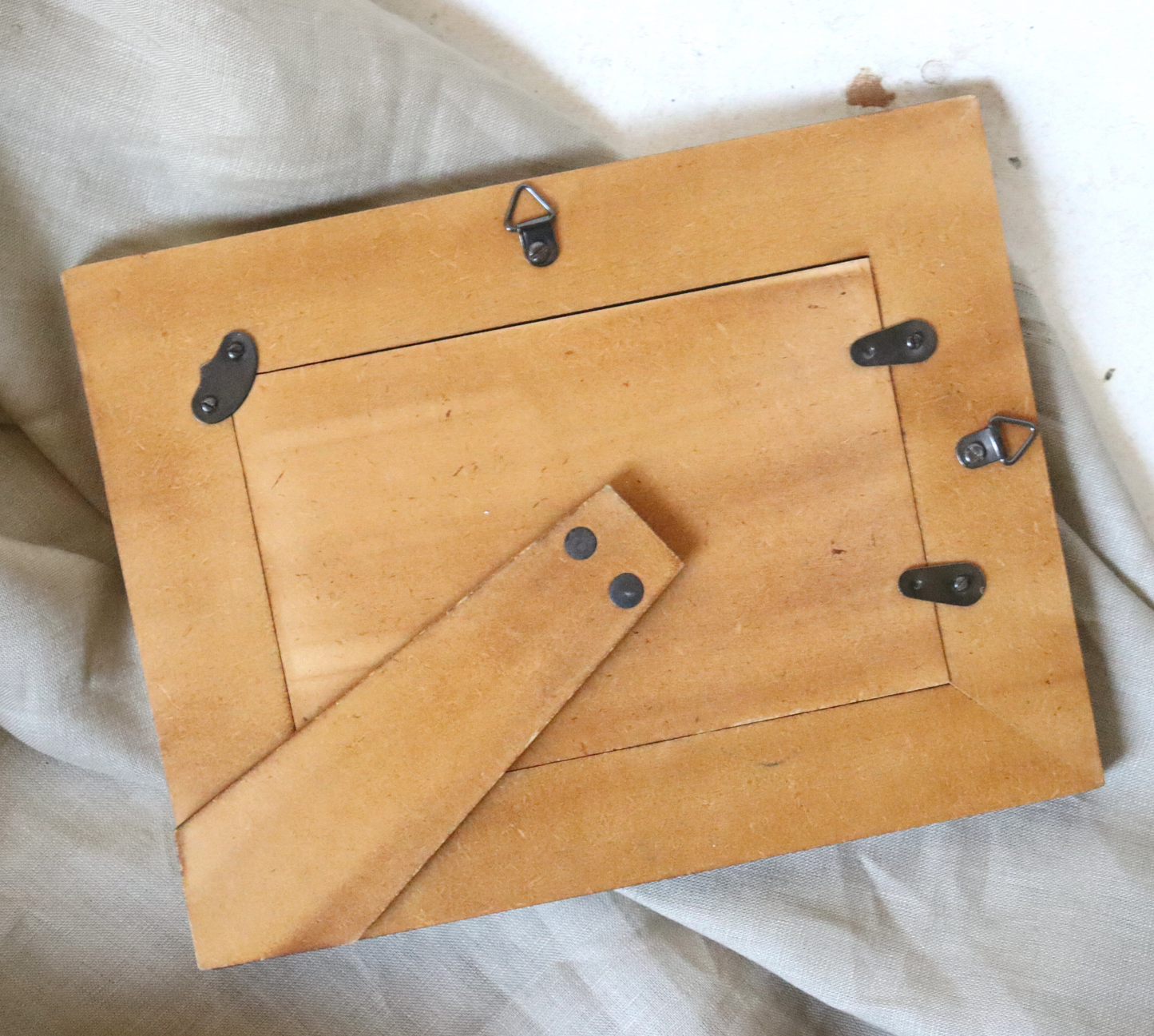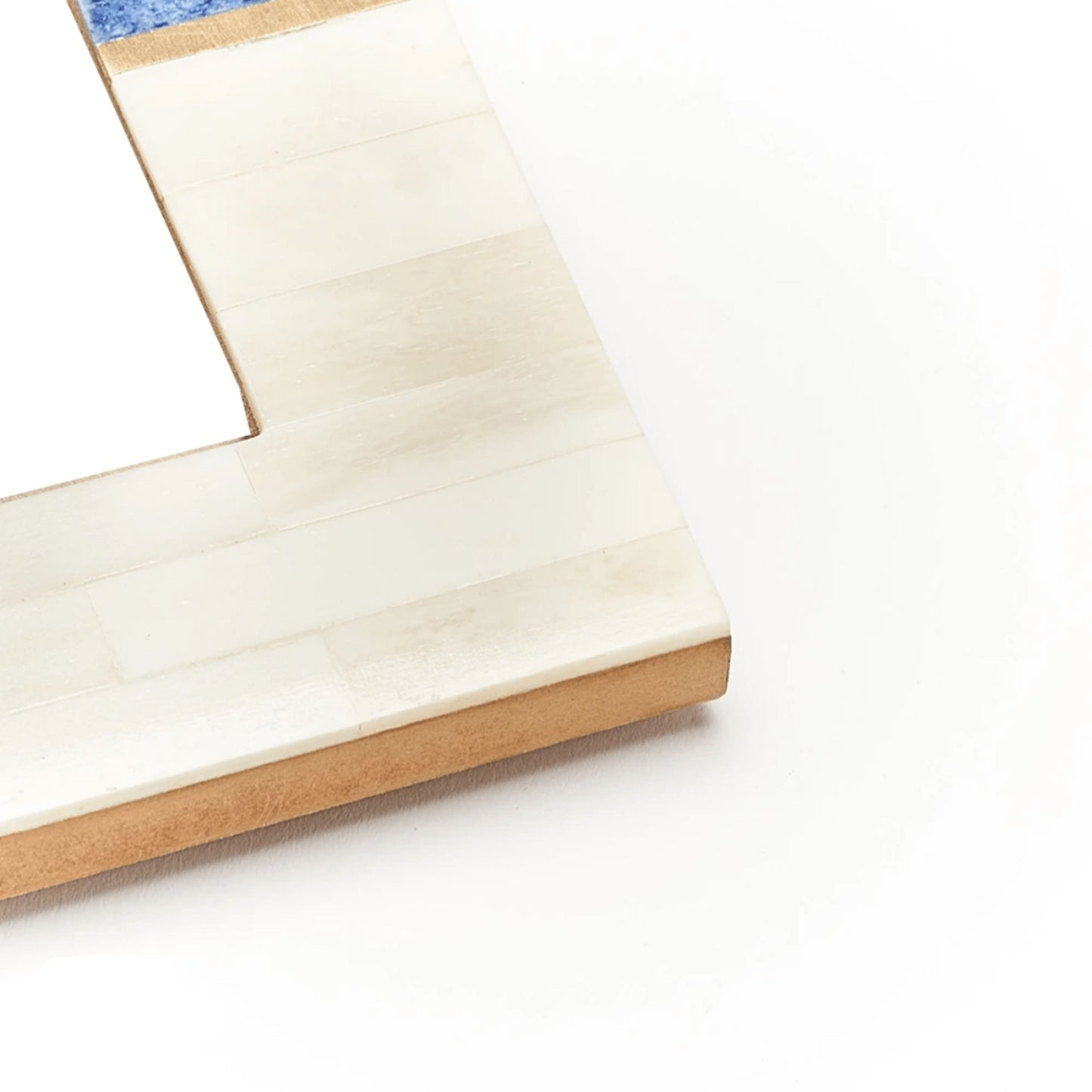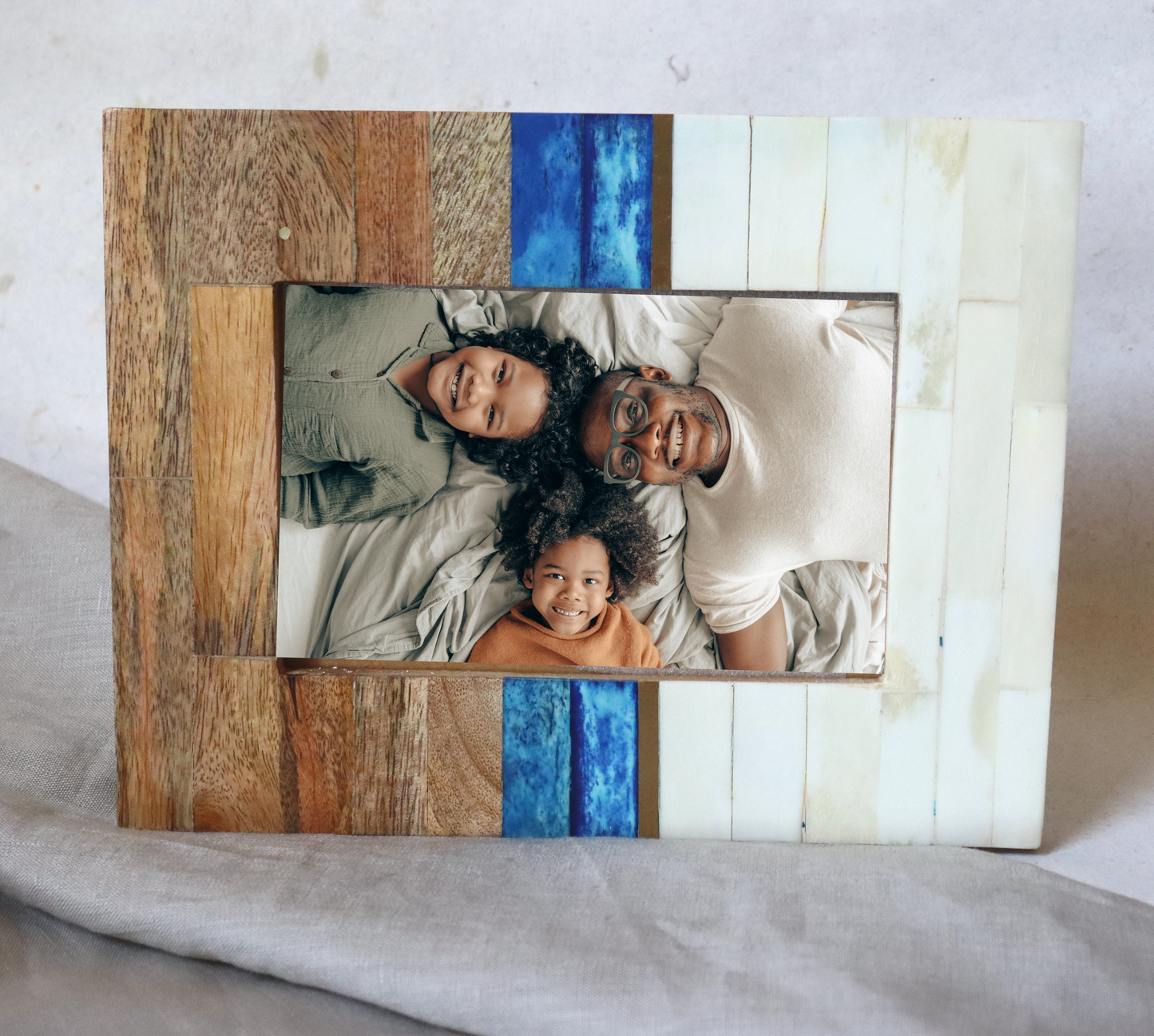Blue White Brown Picture Frame 4x6 Portrait, Hamptons style frame
Blue White Brown Picture Frame 4x6 Portrait, Hamptons style frame
Couldn't load pickup availability
"Classy with a bit of sophistication" - Intricately hand-carved from sustainable mango wood, this picture frame features a multi-tone modern design. The 'brown', 'blue', and 'white' bone design is divided by a brass inlay (part of our Day and Night Collection). The bone is sustainably derived from naturally deceased animals and is cruelty-free.
The vibrant yet subtle colours would match your home decor flawlessly. Keep it on a bedside table, or display your memories in the living room, dining room, or hallway. The handmade frame is an eye-catching piece which makes it perfect to hold your precious photos.
Check out the matching design jewellery storage box here - Day and Night Jewellery Storage Box. Our matching jewellery box has been featured in Herald Sun, Courier Mail and Daily Telegraph magazine. View the feature here - Press
Feature
- Ethically sourced mango wood, sustainably sourced animal bone and brass
- An eye-catching design depicting day and night
- Rectangle shape, Home Decor Gift Idea
- Handcrafted from Wood, Bone & Brass Inlay
- Can be used in Portrait and Landscape orientation
- Single picture frame
- Easy to fill blank tabletop space with inspiring prints, photos, or artwork
- Iron latches for frame closure
- The sturdy leg on the back keeps it upright
- Fair Trade photo frame
- Sustainable Wedding Frame
- Made in India
Picture Size
- Accommodates a 4" x 6" photograph or print
Dimensions
- Width = 6.5"
- Height = 8.5"
Note
Due to the nature of hand-made products, kindly expect slight imperfections. This is not a defect and items are non-refundable due to this reason.
Share







-
Free Shipping over $75
Shipping Policy$10 Fixed standard shipping fee is waived off when the order value is $75 or above (AU) and $100 or above (NZ).
-
-
Buy Now, Pay Later
Choose your favourite service - AfterPay, Zip, Latitude Pay, Klarna
Collapsible content
Why Aksa Photo Frames are the best?
Our range of quality photo frames and picture frames include wooden photo frames, and bone photo frames. Display your special memories, achievements, and anecdotes for a conversation and dinner time stories.
About Indian Woodcraft & Artisans
History of Wood
Since centuries, wood has provided fire, shelter, tools, and supported so many inventions e.g. the wheel. Woodcraft in India is dated back to the ancient times of Maharajas. Initially, the art was limited to carving sculptures and windows of temples and palaces. Over many generations and under the influence of its region's culture and locally available wood the art form has evolved and now extends to articles like furniture, decorative pieces, storage boxes, table lamps, toys and puppets.
What is Softwood and Hardwood?
Wood can belong to either of the two categories - softwood or hardwood. Technically, softwood comes from the botanical group Gymnospermae and hardwood comes from the botanical group Angiospermae.
Most softwood are evergreen, have no flowers and develop their seeds in cones (coniferous). They are usually fast growing. This makes them the most widely used woods commercially. Indian Sandalwood is an excellent example of softwood. It has a fragrant resin, thus is highly sought after for making religious images.
Hardwood are usually slower growing than softwoods. They have dense wood lending itself to greater structural integrity than softwood (durability), and is less prone to insect damage. A few examples are walnut, mahogany, balsa, oak, chestnut, elm, teak and sycamore.
About Artisan's Craft
India has an abundance of native wood that lends well to the carving and inlay work. Some examples are Ebony, Rosewood, Sandalwood, Sheesham, and Sal.
The diversity of each region's style and carving technique reflects in the motifs, and patterns on each carved article. The geometrical and floral patterns are the most popular. When an object is carved from a single block, it is believed that the spiritual energy inherent in the tree remains more concentrated.
To produce a beautiful carving from a block of wood requires sharp tools, suitable timber, and planning. Once cut, the wood can not be reattached and thus the artisan has to be careful while shaping his pattern. Finest carding is possible on hardwood due to its ability to split less, and wide range of colours.
What are different wood carving techniques?
There are quite a few carving techniques, some of which are mentioned below.
- Sawn technique - marking of design on a flat piece of wood, and then cutting using a saw.
- Incising and stamping - Scratching wood, making grooves, stamping
- Chip carving - repetitive patterns cut on one chip at a time.
- Flat-pattern carving - think of the carving required to make wooden stamps or printing blocks that are used for dyeing cloths.
- Relief carving - technique to create a three-dimensional effect on a flat surface by cutting back the background and rounding the projecting objects.

Pic: Relief carving used on an Architectural Ensemble from a Jain Meeting Hall
- Intaglio carving - the opposite of relief carving; think of this as moulding.
- Turning - Spinning wood against a tool. This technique has been used to make our nested dolls.

Pic: Nested dolls in a park setting
- Bending technique - for forming curved surfaces
- Joinery - Joints can either fit against each other, across each other or into each other. They can be used to connect lengthwise or at an angle.
What are different wood decoration techniques?
Once our artisan has craved the product, they can employ a range of decorating and finishing techniques to create the final product. Example of such decorations are paintwork, inlay (insetting shapes into cuts made in the wood), banding, and marquetry (pieces are glued to the surface of a piece of wood).

Pic: example of inlay set in Tic Tac Toe Game Set
Conclusion
In many regions, woodcraft production is vital for community livelihoods. By participating with Fair Trade organisations, we contribute to alleviating poverty and promoting sustainability through ethical practices. These organisations aim to educate and empower disadvantaged sections of the Indian community by providing them with job opportunities, gender equality, fair wages, safe and healthy working environment while preserving the local culture & traditional skills.
Book Reference:
Wood - the world of woodwork and carving








